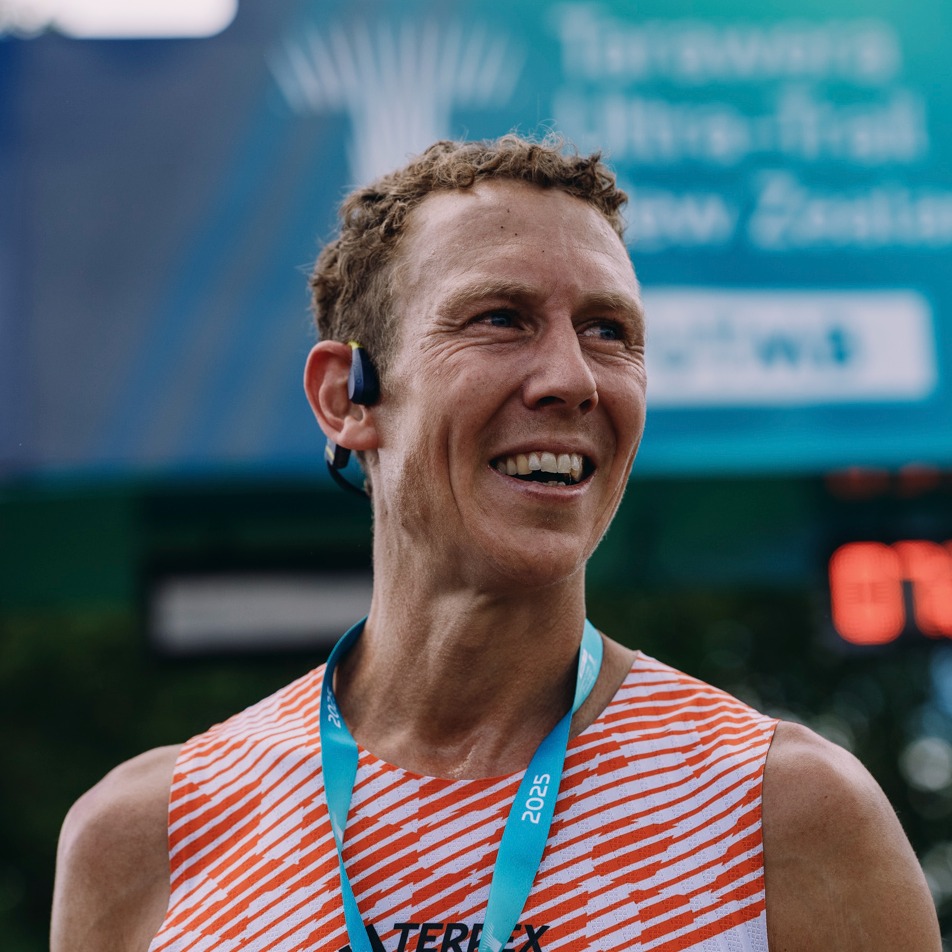
Dan Jones
Tarawera Ultra-Trail 100k
Dan's headline numbers
Dan's strategy
Fueling
Carbohydrate is the main fuel you burn when racing. Failing to fuel properly is a leading cause of underperformance in longer races.
After hitting ~115 grams of carb per hour during his last major race when finishing 4th at CCC by UTMB in 2024, he again hit in excess of 100g/h in his first race of 2025. As in previous events, Dan primarily fueled with PF Carb & Electrolyte Drink Mix and gels. A big change to Dan’s strategy compared to the same race last year is using PF 300 Flow Gel in soft flasks to more efficiently carry his carbs, in place of a large number of PF 30 Gels. Notably, he experienced no major GI issues during the race, highlighting the effectiveness of his gut training to tolerate such high carb intakes while racing. Interestingly, the carb intake he sustained here and at CCC by UTMB in 2024, aligns with recent research on elite runners, which suggests that consuming ~120g/h is associated with a lower perceived effort and reduced muscle damage, compared to 60g/h or 90g/h. This may help explain why Dan felt consistently strong throughout the race and reported a smooth recovery just 24 hours after crossing the finishing line.
Hydration
Taking on board an appropriate amount of fluid and sodium is essential to maintaining blood volume and supporting the cardiovascular effort needed to perform on race day.
Whilst the absolute amount of sodium and fluid consumed per hour is important, it’s critical to consider these in relation to each other. This is known as 'relative sodium concentration' and it’s expressed in milligrams per litre (mg/L). How much sodium you’re taking in per litre of fluid is more important than the absolute amount taken in per hour.
Sweat sodium concentration (mg/L) is largely genetically determined and remains relatively stable. Knowing how salty your sweat is enables you to replace a good proportion of your sweat losses, which can range from 200-2,000mg/L.
Whilst Dan’s losses are on the low side, getting his hydration strategy right is still crucial when it’s hot and/or humid as his higher sweat rate in these conditions can result in significant net losses over the duration of a race.
Learn moreThe majority of Dan’s fluid intake during the race came from PF Carb & Electrolyte Drink Mix, with only a small amount of plain water consumed alongside it. This likely contributed to his relative sodium intake, which was slightly higher than his sweat losses, but this is a strategy that Dan has successfully employed in previous races as well. Dan typically carries his fluid in one or two handheld flasks and often starts races with additional soft flasks pre-filled with PF Carb & Electrolyte Drink Mix, allowing him to simply add water at unmanned checkpoints. This strategy enables him to efficiently sustain a high rate of carbohydrate intake, whilst maintaining his sodium and fluid intake.
Caffeine
Beyond the Three Levers of Performance (carb, sodium and fluid), caffeine is one of only a few substances that is proven to improve performance for most endurance athletes as it can help stave off mental and physical fatigue.
Dan’s caffeine intake during the race fell in line with the general recommendations of 3-6mg/kg, achieved through regular consumption of PF 30 Caffeine Gels. This consistent intake no doubt helped him maintain a consistent circulating concentration of caffeine in his bloodstream, maximising the ergogenic benefits of this stimulant. Beyond carbohydrate fueling, Dan has also focused on training his gut to tolerate caffeine within the recommended range, ensuring he can confidently execute his strategy on race day. Swapping out his pre-race PF 30 Gel for a PF 30 Caffeine Gel could be one way for Dan to increase his caffeine intake towards the upper end of the recommended range.
How Dan hit his numbers
Here's everything that Dan ate and drank on the day...
Dan's weapons of choice
Final thoughts
Dan's full stats
Data Confidence?
There is an adequate level of accuracy in the data collected and the numbers reported. The athlete manages to recall what they ate and drank including most specifics (brands flavours quantities plausible estimations of volumes). However there are estimations made within the data which affect the overall confidence level in the data reported.